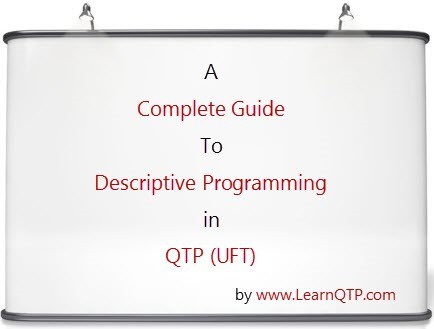Over and above features provided with QTP 9.0 , QTP 9.2 provides following features:
Mercury Screen Recorder :
Capture your entire run session in a movie clip or capture only the segments with errors, and then view your movie from the Test Results window.
Dynamic Management of Object Repositories:
QuickTest now has a new RepositoriesCollection reserved object that you can use to programmatically manage the set of object repositories that are associated with an action during a run session.
Over and above features provided with QTP 8.2 , QTP 9.0 provides following features:
Object Repository Manager:
You can use the Object Repository Manager to manage all of the shared object repositories in your organization from one, central location. This includes adding and defining objects, modifying objects and their descriptions, parameterizing test object property values, maintaining and organizing repositories, and importing and exporting repositories in XML format.
You can open multiple object repositories at the same time. Each object repository opens in its own resizable document window. This enables you to compare the content of the repositories, to copy or move objects from one object repository to another, and so forth.
Object Repository Merge Tool:
You can use the Object Repository Merge Tool to merge the objects from two shared object repositories into a single shared object repository. You can also use the Object Repository Merge Tool to merge objects from the local object repository of one or more actions or components into a shared object repository.
When you merge objects from two source object repositories, the content is copied to a new, target object repository, ensuring that the information in the source repositories remains unchanged.
If any conflicts occur during the merge, for example, if two objects have the same name and test object class, but different test object descriptions, the relevant objects are highlighted in the source repositories, and the Resolution Options pane details the conflict and possible resolutions.
Multiple Object Repositories per Action or Component:
QuickTest provides several options for storing and accessing test objects. You can store the test objects for each action or component in its corresponding local object repository, which is unique for each action and component. You can also store test objects in one or more shared object repositories that can be used in multiple actions and components. Alternatively, you can use a combination of objects from the local object repository and one or more shared object repositories. You choose the combination that matches your testing needs.
XML Object Repository Format:
QuickTest now enables you to import and export object repositories from and to XML format. This enables you to modify object repositories using the XML editor of your choice and then import them back into QuickTest. You can import and export files either from and to the file system or a Quality Center project (if QuickTest is connected to Quality Center).
Function Library Editor:
QuickTest now has a built-in function library editor, which enables you to create and edit function libraries containing VBScript functions, subroutines, modules, and so forth, and then call their functions from your test or component.
Handling Missing Actions and Resources:
Whenever a testing document (test, component, or application area) contains a resource that cannot be found, QuickTest opens the Missing Resources pane and lists the missing resource(s). For example, a test may contain an action or a call to an action that cannot be found; a testing document may use a shared object repository that cannot be found; or a testing document may use a object repository parameter that does not have a default value. In all of these cases, QuickTest indicates this in the Missing Resources pane, enabling you to map a missing resource to an existing one, or remove it from the testing document, as required.
Source: What’s New in Quick Test Professional–QTP Documentation
Please use the QTP forum for posting questions now!
If you want to keep track of further articles on QTP. I recommend you to subscribe via RSS Feed. You can also subscribe by Email and have new QTP articles sent directly to your inbox.







Hi Ankur,
This is an excellent site for beginners. Keep up w/ good work.
I am very new to QTP and need your help. Whenever I am downloading QTP 8.0 or any other version 10.0 it allows me to download, but whenever I am trying to install that in my computer I get pop message saying install Quick Test Professional before installing add-in. Can you please tell me why it does that?? I am not sure is there a Software which is just named Quick Test Professional without any add in. Like I said I am new to this and don’t know what I am doing wrong.
Thanks,
Meghna
Hi Ankur,
I read your blog, Amazing site
everything is useful for QTP learners.Thank you so much for creating this site.
Well,My learning stage is over now am practicing the QTP then planing to take certification. Could you please suggestion me how to read and on which things i have to concentrate more. Any suggestions are accepted. And one more could you tell me where i have to learn VB Script? you can send me a email to qtplearner9@gmail.com.
Thank you once again.
i had exp in manual testing.. i am learning QTP.. due to some i needto write QTP certification.. is basic theoritical knowledge is sufficient to write HP- prodect specilist exam -M16…. i practiced that flight example.. and through with concepts…
@Ashish: Thanks.
>not only win-ruuner but also QTP9.5 supports Power Builder
yes, but QTP 9.2 and below doesn’t.
Hi Ankur,
Firstly thanks a ton for maintaining such a nice & Knowledgeable blog.
Ankur,not only win-ruuner but also QTP9.5 supports Power Builder
I installed QTP 9.5 with Siebel add-in selected at the time of setup. but after installation is over, i’m seeing all other add-ins are licensed except Siebel Add-in. is there any one who have installed QTP 9.5 with Siebel add-in? please give some direction.
Thanks in Advance.
Rishi
Hi Ankur,
I have installed QTP9.5 trial version in my system(XP). Now mercury tours website is throwing 403 forbidden error. After installation once I used the mercury tours application but now its not working and showing 403 error. What should I do? pls help
Hi how could I get QTP 9.5 student hand book? I have installed trial version. Pls help
@Umar: for QTP 9.2 and below you need to purchase the addin seperately but with QTP9.5 all addins are integrated into one license only and there is no extra cost.
Hi Its Umar,
would like to know do we need to purchase java add-in seperate or does it come with pack.
Does the core qtp 9.2 has all the add-ins with it or need to get license for add-ins too.
Where can I get QTP CBT?
I need a Student Handbook for ver.9.0. All I can find is 8.0. It’s rather confusing for a beginner. Can you point me to the Handbook for ver 9.0 or tell me when one will be available?
Thanks,
Brian
@Pankaj
How can I import data from database…..
Ans: Insert -> Output Value -> DataBase Output Value.
Map DB and define SQL query manually in “DB Query Wizard”
Code will be like this:
DbTable(“DbTable”).Output CheckPoint(“DbTable”)
‘Checking wether data is stored in datatable:
msgbox DataTable(“AgentName”, DtGlobalsheet)
What are the differences between QTP 8.2 and QTP 9.5?
Hi Ankur..
How can I import data from database…..
To Praveen,
Qtp 9.2 doesn’t support power bulider.
Cheers!!
Kirti
hi Guys,
Recently Hp released QTP9.5 version
this version supports Power builder. i am sure about that. But i want one information that Does QTP9.2 supports Power Builder or not?
please give me reply as early as possible…
reply me to pravengoud236@gmail.com
Thanks and Regards,
Praveen.G
21Feb2008
Hi, any support will be much appreciated.
We wanted to qtp to record a system running in OS2. However, since QTP is only for Windows, we called the OS2-based system in Microsoft’s Virtual PC. However, when we played a sample qtp script in an attempt to record/control the OS2-system, qtp was not able to access the OS2-based system. Instead it can only activate the Virtual pc window.
Is there a way that we can use qtp script to record/control the OS2-based system in Virtual PC?
Thanks and Regards
Ryan
Email: freesign69@yahoo.com
I am using qtp 8.2. I cannot open result window either from tools/result or by etting the run command to open automatically. Is there any setting I need to set to generate these results? Please help
how to include xml from QC to QTP 9.2 by using pathfinder.locate
Hi All,
Anyone knows that the QTP8.2 has java add-in as it has in QTP9.1 whether or not. I would like to test my web page which is java applet web page.
Thanks in advance. 🙂
Hi,
So ‘Shared object repository’ is not supported in QTP 8.2 at all?
Thanks,
hi guys, my name is Imran abid. this is my first post on this website and i really need your help. I’m working at Cigna, I want to know how to convert manual test cases to automate script, we use QTP and QC 9.0. there are about 4,000 test cases in Quality center which needs to be automated and we just started implementing QTP. Email capitalimran@gmail.com
On what platform is the flight appl in qtp written?
Does qtp support vb.net ?
Do we need to purchase any addins apart from the addins provided to us to test .net applications?
hi,
have one merging and association are the same?
can we do association only shared OR with other shared OR.
3.can we associate local to shared?
4.what is the process for merging in details with navigation and examle.
5.how can we use shared in any action or test or script?
6.suppose if i recored one action in local then i save this in .tsr file,
after this i opened another action,here i went settings>resources>associative rep>click on open>that saved .tsr file opened and clicked on add.
so here have doubt this seond action will take that .tsr obr rep for this or not?
7.totally can u explain in details all those things.
1.how can we do regression testing?
2.how can we parameterise with environmental variable give one example plz?
3.how we handle dynamically changing object its very imp for me bcz am working with one of the banking application,
hi,
have one merging and association are the same?
can we do association only shared OR with other shared OR.
3.can we associate local to shared?
4.what is the process for merging in details with navigation and examle.
5.how can we use shared in any action or test or script?
6.suppose if i recored one action in local then i save this in .tsr file,
after this i opened another action,here i went settings>resources>associative rep>click on open>that saved .tsr file opened and clicked on add.
so here have doubt this seond action will take that .tsr obr rep for this or not?
7.totally can u explain in details all those things.
@Chumki:
Generally this error occurs when you try to use string in place of integer or vice versa. Please see that this is not the case with your script.
@Anon:
QTP doesn’t support, only Win Runner supports Power Builder
The QTP version comparison section does not tell about any enhancement regarding the plateforms like “Power Builder”. Has any of the latest QTP versions started supporting power builder. Last I heard that Mercury will will incorporate PB in future…not sure if this is already done. Ankur/anyone, would have any answer for this?
While I am accessing tab in QTP
using the code “Browser(“Admin/Super User ICS402”).Page(“Admin/Super User ICS402”).Frame(“logo”).JavaApplet(“Main”).JavaInternalFrame(“System Level Rules (UOASYSC”).JavaTab(“TabBar”).Select “Service””
I am getting unspecified error…
How can I overcome the problem